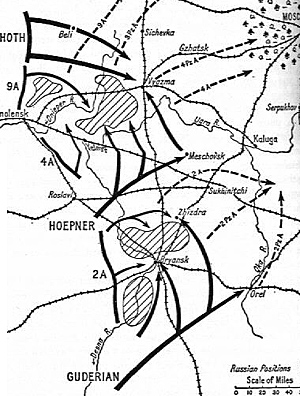 German Army Group Centre was just 200 miles from the Soviet capital, when
Hitler ordered it to swing south towards Kiev in Ukraine and trap and
destroy the bulk of Russian forces in the south. That order was given on
23rd August, 1941. In less than thirteen days, the Germans had won the battle of
Kiev. How Hitler once again ordered Army Group Centre to advance towards
Moscow. In his Directive No.35, he stated:
German Army Group Centre was just 200 miles from the Soviet capital, when
Hitler ordered it to swing south towards Kiev in Ukraine and trap and
destroy the bulk of Russian forces in the south. That order was given on
23rd August, 1941. In less than thirteen days, the Germans had won the battle of
Kiev. How Hitler once again ordered Army Group Centre to advance towards
Moscow. In his Directive No.35, he stated:
Map from: Barbarossa, page 156.
- "Combined with the progressive encirclement of the Leningrad area, the
initial successes against the enemy forces in the area between the flanks of
Army Groups South and Centre have provided favourable conditions for a
decisive operation against the Timoshenko army group which is attacking on
the central front. This army group must be defeated and annihilated in the
limited time which remains before the onset of winter weather. For this
purpose it is necessary to concentrate all the forces of the Army and Air
Force which can be spared on the flanks and which can be brought up in time"
The attack on Moscow was given the code-name Typhoon. OKH, the Army High Command, undertook the planning for Operation Typhoon in conjuction with Army Group Centre planning staffs. The attack was to be carried out by seventy divisions, of which only 14 were panzer and 8 were motorised infantry. Strong efforts were made to bring Panzer Groups 2, 3, and 4 to full strength. As a result, 1,500 tanks would spearhead the offensive.
The General staffs, once again, planned the strategic tactics of double encirclement to achieve victory. The operational plan was to launch two strong pincer movements which would meet at Vyazma. The northern pincer, consisting of 9th Army and Panzer Group 3, would meet the southern pincer, which consisted of 4th Army, and Panzer Group 4, at Vyazma.
These pincers would actually take the German Army eighty miles in the Soviet rear and more than 100 miles west of Moscow. Once these objectives were achieved, a second double encirclement would be launched and Moscow would be captured. To the south, part of Panzer Group 2 (or 2nd Panzer Army as it was designated after 6th October) and 2nd Army would launch a pincer operation which would meet at Bryansk, which was some thirty-seven miles behind the Soviet front.
The rest of General Guderian's 2nd Panzer Group would attack and capture Tula, which was 105 miles to the south of Moscow. Guderian's movements towards Tula would not only protect the flank of the main pincers but would also place the German Army in a good position to finally envelop Moscow.
This whole operation would start over an initial front of 400 miles, and Army Groups North and South would provide flank protection for Army Group Centre.
Facing the Germans were fifteen Russian infantry armies made up of 800,000 men. These were dug in Moscow's firt line of defence. Within it three defensive lines protected the capital. The Bryansk Front (Army Group) was commanded by General Eremenko and the West Front (Army Group) was under General Konev, which contained 14 armies with 77 divisions of which six were armoured and six cavalry.
More Operation Typhoon: Battle of Moscow
Back to Table of Contents -- World War Two Newsletter May 2002
Back to World War Two Newsletter List of Issues
Back to MagWeb Magazine List
© Copyright 2002 by Shahram Khan.
This article appears in MagWeb (Magazine Web) on the Internet World Wide Web.
Other military history articles and gaming articles are available at http://www.magweb.com